Author: Bradley S. WILSON Date: 2014-9-23 19:17:28
MINERALIZATIONOF THE BROKEN HAMMER ZONE
The Broken Hammer zone Cu-Ni-PGE deposit is located approximately 17km north of Val Caron in Wisner Townshipand 30 km north of Sudbury.
The de-posit also lies 1.3 km north of the presentexposure of the SIC footwall contact.
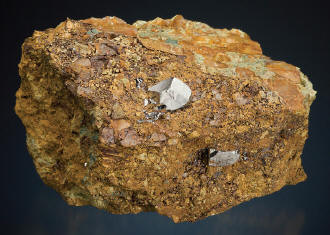
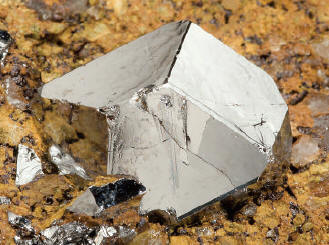
General view of the specimen and closeup of the sperrylite crystal in breccia matrix. Crystal 1.5 cm wide. Wallbridge specimen. M. Bainbridge photos.
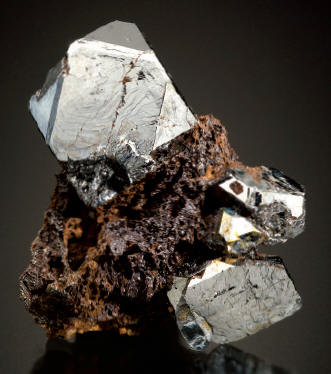
Sperrylite-rich specimen, the biggestcrystal 1.5 cm high. Wallbridge specimen. M. Bainbridge photo.
Mineralization occurs within and adjacentto the Sudbury breccia that developedin quartz monzonite, gabbro anddiabase. The Cu-Ni-PGE minerals aredistributed in massive sulphide veins, asdissemination/replacement sulphides,and in quartz-dominant veins within thebrecciated mineralized zone. Magmatichydrothermalfluids played a significantrole in the formation of the mineralizationin the Broken Hammer zone.
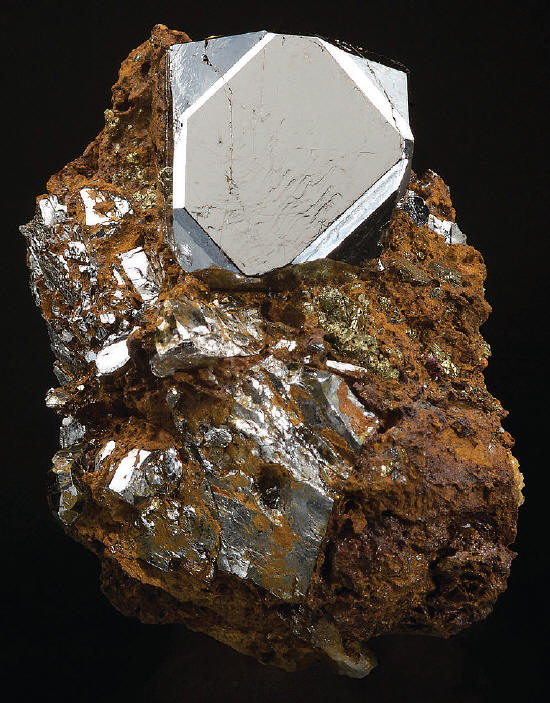
Sperrylite, specimen 2.9 cm high. Wallbridge specimen. M. Bainbridge photo.
In 2003, the Wallbridge Mining Companydiscovered platinum and other metalsin an area not previously known tocontain mineralization. This area waslater named the Broken Hammer zone.
During the next phase of exploration thezone was delineated by drilling, surfacestripping and sampling. In November2005, Wallbridge Mining Company Limitedannounced that the Broken Hammerzone had an inferred mineral resourcetotal of 251,000 tonnes averaging 3.80grams per tonne precious metals (Pd1.56 g/t, Pt 1.62 g/t, and Au 0.61 g/t),1.00% Cu, and 0.10% Ni. Stripping of thesurface revealed a zone of complex geologyand a number of massive chalcopyriteveins up to 1 meter wide, the largestof which was named the “Big Boy vein”.
The main ore minerals in the BrokenHammer zone are most likely sperryliteand merenskite for Pt, gold-silveralloy and native gold for Au, merenskiteand malyshevite for Pd, millerite for Ni,and chalcopyrite for Cu.
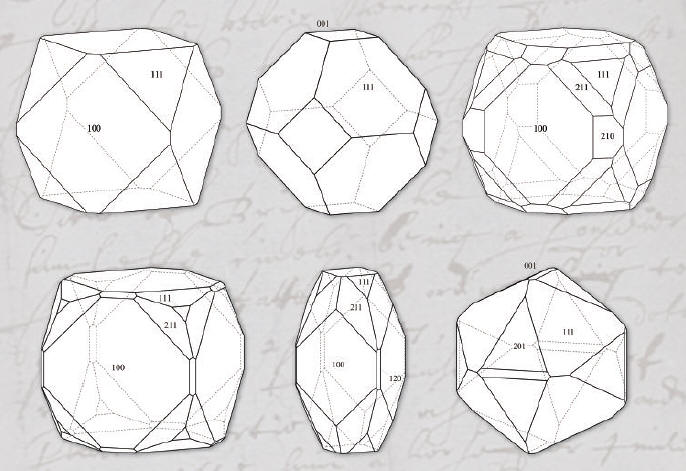
Idealized crystal drawings of sperrylite crystals from the Broken Hammer Zone. A. Recnik drawings.
The complete list of sulphides andsulphosalts from the Broken Hammerzone is quite long. The most commonsulphides are chalcopyrite, millerite,bornite and covellite, while pentlandite,sphalerite, pyrite, and pyrrhotite arerare. A. Péntek with others in 2008 identifieda suite of rare metallic minerals that occur mostly as tiny grains inthe mineralized zone; these includebohdanowiczite (AgBiSe2), clausthalite(PbSe), crerarite (PtBi3S4-x), gold-silveralloy (Au65Ag35), hessite (Ag2Te), kotulskite(PdTe), melonite (NiTe2), merenskyite(PdTe2), michenerite (PdBiTe),moncheite (PtTe2), native gold, naumannite(Ag2Se), sopcheite (Ag4PdTe4),tetradymite (Bi2Te2S), tellurobismuthite(Bi2Te3), malyshevite (which was an unnamedPd-sulphide in 2008) (CuPdBiS3),violarite (FeNi2S4) and wittichenite(Cu3BiS3).
DISCOVERYOF SPERRYLITE CRYSTALS
In the Broken Hammer zone, completesperrylite crystals to several mmand crystal fragments to 7 mm werefound and documented for the first timeby company personnel during earlyphases of exploration. In spring 2006, theauthor visited the site, which at the timeconsisted of a small cleared and washedarea of outcrop in the surrounding forestlocated about 1.5 kilometers from thenearest gravel access road. In October2006, the author returned to collect sperrylitecrystals. Nearly a dozen smallcrystals were found, the largest of whichwas 1.5 mm across.
In January 2011, Wallbridge announcedthat the extraction of a 30,000-tonne bulk sample was underway. Thislarge sample was taken to verify metalgrade estimates determined from initialchemical analysis of drill core and for detailedmetallurgical testing which willhelp determine the best extractionmethod for recovering the greatest percentageof each metal from this deposit.
By the end of June 2011, the sample wasdelivered to Xstrata's Strathcona Mill, locatedin the Sudbury area, for processing.
It was during the extraction of thissample that large sperrylite crystalswere discovered.
Tom Johnson, an employee of WallbridgeMining Company Limited, collectedthe largest of the new sperrylitecrystals in early spring 2011. In May2011, the author returned to the site andcollected a suite of sperrylite specimens.
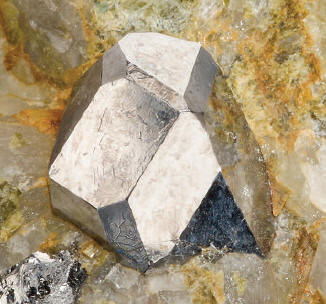
Sperrylite crystal 9 mm high. Wallbridge specimen. M. Bainbridge photo.
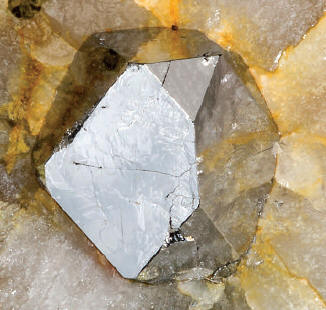
Sperrylite crystal 9 mm high. Wallbridge specimen. M. Bainbridge photo.
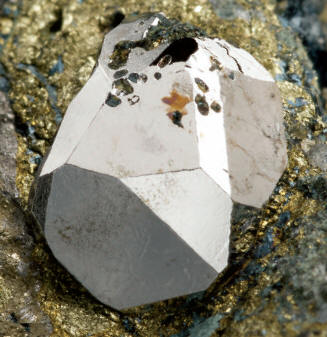
Sperrylite crystal 7 mm high. Wallbridge specimen. M. Bainbridge photo.
Wallbridge then temporarily covered thecrystal-bearing zone around the edge ofthe pit with earth to prevent potentiallyvaluable sperrylite specimens from beinghigh-graded. In late August 2011, theearth was removed using heavy equipmentand then the locality was washedoff using high pressure water to remove as much of the remaining earth as possible.
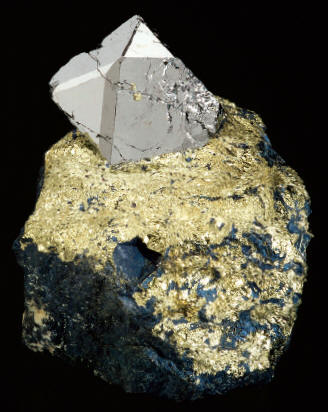
Sperrylite crystal in chalcopyrite from the Broken Hammer zone, Sudbury, Canada. Specimen 3.3 cm high. M. Bainbridge photo.
This was done to allow detailed geologicalmapping of the entire pit bycompany geologists. At this point in time,Tom Johnson and the author returned tocollect additional specimens. The zonehosting most of the largest crystals hasnow been removed in order to collect potentialcrystal-bearing rock that waslater processed for specimens. A secondcrystal-bearing zone, a few meters lower down the pit wall, produced most of thesmaller sperrylite crystals (<5 mm). Themost accessible parts of this zone havenow been removed as well.











 YueGongAnBei 44051102000467
YueGongAnBei 44051102000467


 |
|